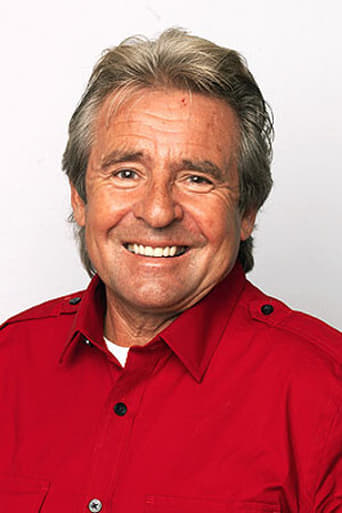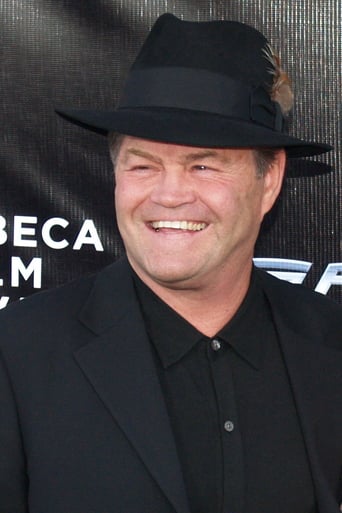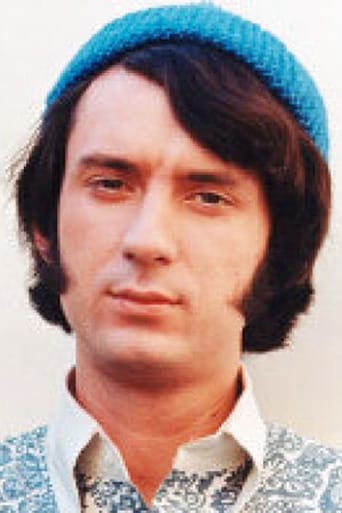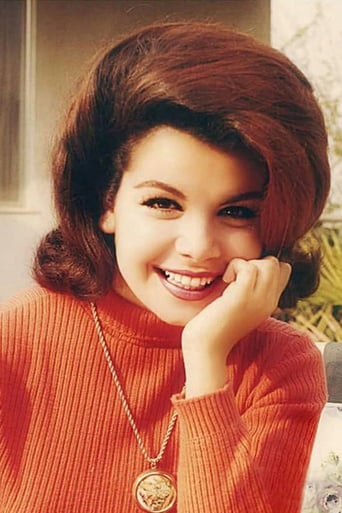Hottoceame
The Age of Commercialism
SnoReptilePlenty
Memorable, crazy movie
Pluskylang
Great Film overall
Frances Chung
Through painfully honest and emotional moments, the movie becomes irresistibly relatable
thor-teague
This criminally underrated film, released in 1968 as the last "hurrah" for the Monkees, was intended to be end of the idea of the Monkees. Their career was on a rapid, stupefying decline. What they created was an epic acid trip, a bitter criticism of mass media and pop culture, and a surreal deconstruction of the IDEA of The Monkees--thus alienating the fans of the original show, and with the baggage inherent in BEING the Monkees, the young adult philosopher & artist crowd were unlikely to take interest. With a shoestring budget and poor marketing, it failed utterly in the box office. I was first turned on to this film by a friend of mine almost 10 years ago and it has yet to stop fascinating me.This film is many things, and the story surrounding it is as important as its content. As you peel away its layers, it reveals more and more to you. Some of the puzzle pieces actually require some research, and I have no doubt that there is more to be understood about this film than what I currently know of.On the most superficial surface layer, it appears to just be The Monkees being silly with significant format changes from the show. Presented are a series of disconnected sketches that could plausibly have been part of the serial, although edgier. It is technically an extended Monkees episode--gag driven sketch comedy, absurd, and inflatable.However, when you deflate the film you are surprised to find that, unlike the TV show, it actually is not empty, and you get to the essence of what this film actually is. The Monkees were, in the film's own words, "a manufactured image with no philosophies," its artistic choices were dictated by corporate committee, and, legions of misguided Monkey-haters to the contrary, they had incredible talent. For some reason, perhaps lack of education, people projected this frustration on to the four guys themselves and mocked them mercilessly, which is a fundamental misunderstanding of media culture. Yes, the Monkees project is manufactured. The four individuals themselves, however, were innocent pawns.I have a difficult time understanding why people never got that; continue to not get it.Knowing this was their last hurrah, they recklessly deconstructed their own image. So here we have this motif of a self-aware fictional band put through manufactured situations attempting to become real. The underlying desire to be legitimate colors everything in this film. It is absolutely futile. Even if corporate media would allow it, the public wouldn't. Soon they are trying to break out, tearing up costumes, breaking the fourth wall, walking off set, waking up dead extras, any rule of cinema you can think of was broken. They individually tried, in futility, to break from character. Davie tries in vein to become a boxer, but it's just a publicity stunt. Mickey Dolenz tears off the fake arrows and kicks over the fake set to no avail. Peter's the dummy. He's always the dummy. Look through the metaphor. As human beings, artists, they were trying to break free from the image that they themselves were fictitious. They set out to accomplish this with the mentality that it was hopeless, I suspect. They get so desperate they actually start committing acts of war (blowing up the Coke machine, a simple but effective statement about corporate sponsorship), murder, and finally they commit suicide by jumping off a bridge. Even then it is not enough for them to break free of the image that's been created for them. Their deaths were just another scene for the film, and they are simply put in a tank and hauled off to storage for the next production.Another layer to this film concerns some of its symbolism. The all-encompassing box represented their confinement both by pop culture and by their hateful director who forced them to break/lunch in a tiny room not unlike the Head box. They feel like marionettes being made to dance for their puppeteer's pleasure, forced to carry on this charade. This is why the only place in the film free will is discussed or even considered is in the box.The final example I'll bring up--the list goes on but possibly the most telling, is the appearance of industry people in the film. If the party is watched frame by frame, you can see the director showing himself holding the camera in the mirror. And Victor Mature appears as a Godlike figure towering over the four, kicking them around. The sequences that include Head's staff in these contexts remove any doubt as to what this film is really all about.They knew there was no chance whatsoever of this film ever receiving the recognition it deserved, and 40 years later that appears to still be true. But this mentality was huge to the underlying meaning behind this film, and what they actually were able to do with it. The Monkees at some point ceased to feel like people and started to feel like products. This film is an expression of the bitterness and resent created by the situation they were forced into and the people that forced them into it, and in a sense a triumph that their true selves finally came through and real art was created--against the most impossible of odds. In the end, real expression was accomplished and the Monkees project matured.What the whole Monkees project, capped off with this film, accomplished, belongs with Andy Warhol and his multicolored photocopied Marilyn Monroes, and any number of likeminded self-indulgent postmodern/pop culture deconstructionist artists forced down the throat of every art student since 1970.There is no other pop group before or since that could have created such a scathing, incisive criticism of media and popular culture. The factors that came together to create this situation, and subsequently, "Head," are completely unique and I highly doubt they would ever happen again.Hey hey, they're The Monkees.
Dave from Ottawa
I grew up watching the Monkees on TV, and when I was old enough to own my own stereo, I got both of their Greatest Hits albums. On vinyl. To say that I eagerly awaited the VHS release of their single long lost feature, HEAD, back in the mid-80s is an understatement. I was pestering video clerks for a solid year until it appeared on the shelves. And when I finally watched it... I found myself confused, disappointed and bored. The music was different from the more familiar pop-friendly tunes on the show - darker lyrically and musically - but that was okay. Musical groups evolve and change. The movie lacks a coherent story line and often makes no sense whatsoever, but part of the appeal of their show was its scatter-shot approach to anarchic comedy. The individual vignettes which often spoof classic Hollywood warhorses and which make up most of the movie's length are silly and don't really go anywhere, but then the show was not exactly a story-driven affair either. Ultimately, what made the show irresistible was the individual appeal of the four Monkees themselves and their chemistry as a group, and the movie simply doesn't give us any of that, substituting instead a bizarre parade of unrelated images and events that lacks for any coherent or unifying viewpoint. It's much ado about nothing and when it's over, the viewer finds himself wondering, Is that it? Was that the best they could come up with, given Bob Rafelson as director, Jack Nicholson as head screenwriter and two months of studio time? Ultimately, HEAD's a harmless trifle, but it's one of those late 60s movies like CHE or HIERONYMUS MERKIN that just leave you wondering when the clowns took over the circus. These movies came out while the Hollywood old guard who were still in charge of the studios were green-lighting stuff that they hoped would appeal to a youth audience whose tastes were beyond their understanding. The movie might appeal to Monkey fans or maybe not, but keep your expectations low.
Mike Kiker
I love The Monkees, probably the most underrated pop group of all time. Well known for being TV darlings in the '60s, but not as well known for trying their best to shake off the image by actually playing their instruments in concert (unlike the pop stars of today, but that's for a different website), writing their own songs, supporting some major breakthroughs in music like the Moog Synthesizer, and helping give (at the time) struggling artists like Frank Zappa, Tim Buckley, and Harry Nilsson a fair shake.And for the evidence to everything I just said, look no further than 'Head', considered by many Monkees fans (including this one) and the Monkees themselves to be their crowning achievement. Yes, it is a plot less mess, but it's on purpose (or could you say "on porpoise"? Sorry had to get that joke out. Yes, it is terrible, but on porpoise. D@MN! Did it again, sorry, back to the review...) But within this plot less mess are some great shots taken at the entertainment industry, the faux spirituality that seems to run rampant with celebrities (And this was 35 years before Tom Cruise was promoting Scientology!) and the political climate of 1968. For example; the dandruff commercial, Mickey torpedoing the Coke machine, the War! cheer, the punching scene, the black box, the Swami and Peter know-nothing speeches, the Frank Zappa and Cow commentary. All present various allegorical statements on their treatment in the media, and what they've come to know in the world of fame, and are done brilliantly.As for the music and their accompanying scenes, top notch! First the Monkees' Theme parody "Ditty Diego-War Chant" is set to random television gridlock imagery. The scene for Mike Nesmith's "Circle Sky", intermingles footage of prepubescent female hormonal cacophony from a live Monkees show with the footage of war, "Porpoise Song" (written by classic songwriting team Carole King and Gerry Goffin), a song that's up there with the trippiest of pop songs, is set to solarized negative images of Mickey Dolenz and 2 mermaids, emphasizing the song's psychedelic nature. Great cover of Harry Nilsson's "Daddy's Song" set to an equally visually stunning dance number by Davy Jones and Toni Basil. "Can You Dig It?" by Peter Tork set to Middle-Eastern belly dancers. King & Goffin's serene "As We Go Along" is set to slow motion footage of The Monkees in the woods. And "Long Title: Do We Have To Do This All Over Again?" gets the best scene of all by subtly being overtaken by Mike Nesmith's grief during the trippiest of tripped out parties, only to end suddenly with Mike Nesmith berating everything, including Christmas! So, in a nutshell, expect everything you know and love about the Monkees to be shattered! But enjoy this ride, in a present state or an altered one!
Professor Klickberg
For once, the qualifier "____ on acid" works here. This truly is "Hard Day's Night etc. etc.", with not only psychadelica and "grooviness" all the way, but true philosophic discourse and existential wonderment that will make you think as much as it will make you laugh.Imagine tripping to an episode of the Brady Bunch while pondering the nature of reality vs. illusion. It's all here in Head, but you must be warned: it is a trip, and as such, comes with as many lows as highs. There are certainly moments of nightmarish quality, but overall, it's worth the ride. It's just surprising that a group like the Monkees would be involved in such an undertaking, and probably a large reason this movie has never been taken more seriously or acknowledged as something truly special.Best not to learn too much about it before you see it except to know that it stars the Monkees, is co-written by Jack Nicholson (back in the day), and directed by Bob "Five Easy Pieces" Rafelson. It'll make you laugh, it'll make you rethink your entire perspective of media and the 60's, and might even scare you a few times with a sense of "the Fear" that is mixed wonderfully with beatific music that will also make you rethink the music of the Monkees (and whether or not they actually play or not is moot; it's truly great stuff). If Oliver Stone (in the 90's) and Quentin Tarantino were to get together and produce their own series of Monty Python episodes, it would end up something like this... as long as it were shot like and used the musical ques of sitcoms from the mid-60's. Enjoy... But be careful... You will be surprised.




